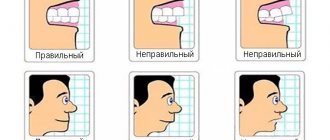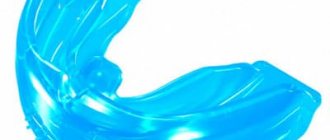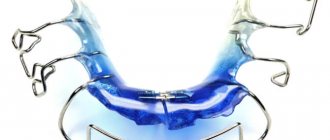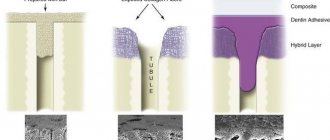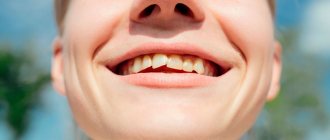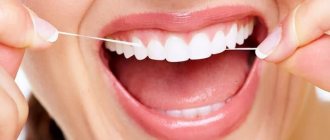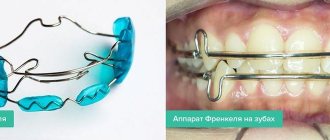Dental care begins in the first year of life, when the first milk teeth erupt. Particular attention should be paid during the period replacing baby teeth with molars
. And if any problems arise: malocclusion, uneven alignment, brackets are installed on the teeth to correct them.
Installation of braces in adulthood
Orthodontic treatment with braces in Russia goes back about thirty years. And in the USA, for example, bite correction with braces has been practiced for more than a hundred years. Russian orthodontists today often work with adults who simply did not have the opportunity to undergo this level of treatment in childhood. As a rule, such patients themselves turn to the dentist, less often - through the referral of related specialists. As a rule, people come to orthodontists for a beautiful smile, and not because of any pain. Most of those applying are women. Men are more relaxed about imperfect smiles, although doctors have recently noted an increase in the number of male patients.
Bottom line
Crooked teeth do not look aesthetically pleasing, which leads to the development of communication complexes. However, an ugly smile is not so bad. Uneven dentition leads to the formation of an incorrect bite, and this is fraught with the development of various pathologies of the digestive organs. Parents should bring their child to see an orthodontist as early as 7-8 years old to clarify problems with bite and dental alignment.
For adults, braces and staples are prescribed to correct bite pathologies. The wearing period of orthodontic structures after 25 years increases significantly due to the strong fixation of the roots of the teeth in the socket; however, braces even out the teeth of adults. The choice of braces depends on the financial condition of the patient, since the material of the products can be very expensive. The most affordable option is simple metal (or plastic) structures.
Staples provoke the accumulation of plaque, in which pathogenic bacteria actively multiply. To avoid inflammatory processes on the mucous membrane, use herbal rinses and antiseptic infusions.
Sources used:
- Persin L. S. Orthodontics, M., 1999
- Guide to prosthetic dentistry, ed. A. I. Evdokimova, M., 1974
- Ministry of Health of the Russian Federation
Does it make sense to get braces as an adult?
Correcting a pathological bite or incorrect position of teeth is, of course, not a matter of life and death. Rather, it is a matter of regaining self-confidence. The “curvature” of teeth has little effect on communication; after all, we perceive a person holistically, and not solely the state of his bite. But, you see, an open wide smile of any person will make him more attractive in our eyes. And only people who are not embarrassed to show off their teeth smile like that. Plus, when we talk about bite, it's not just about beauty, it's also about functionality. Nature intended that when chewing, the load on the teeth should be distributed evenly - this is only possible with straight teeth and a healthy bite. If this is not the case, then over time a person develops problems with the dental system: pain appears, clicks when opening and closing the mouth, etc. Therefore, orthodontic treatment for adult patients is not only possible, but also necessary.
Braces for children
Pediatric dentists use such systems quite often. They are easy to install, quickly removed and work well in conditions where the bite is not fully formed.
Parents can tell that a child has dental problems by the following signs:
- the enamel has sharply darkened and thinned, the baby complains of pain when chewing food;
- the child sleeps poorly at night, often sucks his thumb in his sleep;
- difficulties arise with nasal breathing (it is replaced by breathing through the mouth);
- The size of some dental crowns has decreased.
All of these signs indicate that some area of the mouth is placing too much stress on the jaw. If orthodontic treatment is not carried out in time, the situation will worsen. At an older age, problems with permanent bite may occur.
At what age does it make sense for adults to get braces?
In any case, there are no age restrictions. There are surmountable obstacles: the general condition of the teeth, periodontal and gum diseases, and possible common concomitant diseases. Absolute contraindications for installing braces for adults coincide with many other types of treatment: lack of teeth, tuberculosis, diabetes, a number of immune diseases, epilepsy, bone pathologies, blood diseases. If a person gets braces when he is over thirty, the treatment will be quite long, since tissue regeneration occurs more slowly due to age. Plus, skeletal growth has already been completed, and the position of the bones can be “corrected” only when they are still growing - in childhood and adolescence. However, dentists achieve excellent results with mature patients.
Contraindications
Situations when staples cannot be installed may vary. Temporary contraindications include:
- Poor oral hygiene. Then you first need to carry out professional hygiene.
- Untreated caries. First you need to “close” all carious cavities.
- Progressive pulpitis, periodontitis, periodontal disease, gingivitis. Any dental ailments must be treated before bite correction begins.
- Individual intolerance to metal, acrylic. You need to choose a device that is made of hypoallergenic material.
Among the absolute contraindications to staple correction of malocclusion:
- pulmonary tuberculosis;
- tumor neoplasms (with and without metastases);
- diabetes;
- epilepsy, severe neurological disorders;
- AIDS, HIV;
- mental disorders.
Before making and fixing brackets on your teeth, you must undergo a diagnosis and dental examination. The doctor will tell you whether it is possible to correct the bite in this way and when it is best to do it. Typically, during diagnostic procedures, radiography or panoramic tomography of the jaw is performed.
Specifics of treatment with braces in adults
Adult patients should keep in mind that it is often necessary to remove teeth to achieve a high-quality result of orthodontic treatment. This does not mean that every patient needs it; removal is carried out only in cases where there is not enough space to restore the normal position of the teeth. Foreign orthodontists change the jaw size of adults using surgery. In Russia, orthognathic surgery is not yet particularly widespread due to the fact that our patients are extremely reluctant to agree to undergo operations. Let us repeat that this is just information about how it might be. In most cases, orthodontic treatment for adults is limited to simply installing braces.
Does a plate straighten teeth: indications
Children are prescribed plates for the lower teeth and expansion plates for the upper and lower teeth only after a thorough diagnosis. Based on X-ray and panoramic photographs, measurements and study of proportions, the orthodontist decides to place a plate on the child’s teeth.
Treatment is indicated for:
- minor and serious anomalies of dental bite;
- violation of the tone of individual muscles;
- pathologies of tooth growth in the upper or lower jaws;
- incorrect position of incisors and canines;
- disproportionate growth and development of the dentofacial rows.
Orthodontic removable appliances equalize the growth rate of the jaw bones, straighten teeth in given planes, and correct the closure of the jaws.
Which braces are most often installed in adults?
It is most rational to choose metal braces: they are the most durable, and since the treatment will be long, this is one of the most important indicators. When it comes to minor corrections, aesthetic systems made of ceramics or artificial sapphires can be installed. But, let’s say, ceramic braces are quite fragile compared to metal ones. If the ceramic lock is chipped, you will need to remove it and install a new one. And this is a waste of time: when the lock is re-glued, the treatment can be considered to begin anew. When choosing a brace system, it is best to listen to the orthodontist’s recommendations - the doctor selects or combines types of structures so that the treatment is as comfortable as possible.
System care
A person can remove the staple from the oral cavity on their own, but this is not necessary. The device's locks are quite fragile. Without certain skills, they can be easily broken. Then you will have to pay for the production of a new system.
To quickly get positive dynamics, it is important:
- Don't skip dental checkups. During them, the doctor evaluates the changes that have occurred and, if necessary, tightens the arch.
- Pay special attention to hygiene procedures. After each meal you should rinse your mouth with warm water. Teeth should be brushed in the morning and evening after meals. To strengthen the gums, use herbal decoctions. It is better to avoid pharmaceutical rinses for a while, as they can provoke oxidation of the metal. Braces do not allow you to properly clean your teeth. Therefore, in addition to a regular brush, you need to use floss, irrigator, and interdental brushes.
- Avoid nuts, toffees, baked goods - any viscous products that stick to metal elements.
These rules must be followed throughout the entire orthodontic treatment. And it can last from several months to two to three years.
Is it possible to correct an adult's bite without braces?
You can - with the help of aligners. These are orthodontic transparent aligners made of solid polymer. Despite their rather simple appearance, aligners cope well with both minor changes in the position of the teeth and quite serious pathologies of the dentofacial apparatus. When treating with orthodontic aligners, patient motivation is extremely important. Aligners are more often chosen by men - they think that this type of treatment is less problematic. But they often lack patience and remove the aligners as soon as they feel discomfort. And this is unacceptable if the patient expects a positive effect of treatment. Aligners need to be worn 22 hours a day - keep this in mind before choosing this treatment option. If you comply with this requirement, then treatment with braces will not be necessary - mouthguards are no less effective at restoring the anatomically correct position of the teeth and correcting the bite.
Types of orthodontic plates
Depending on the type of construction, individual vestibular plates can be removable or non-removable. We will not consider fixed structures, since they are used extremely rarely in orthodontic practice.
7 types of removable orthodontic vestibular plates:
1. Frenkel system – a removable plate with protective elements for lips and cheeks;
2. For one jaw – a vestibular plate, which is used to correct the position of single teeth;
3. Bruckle system - a plate designed to correct a strongly protruded chin;
4. A plate equipped with a retraction arc - a device that is necessary to correct the position of the incisor teeth;
5. The Andresen-Goipl system, affecting the lower and upper jaws;
6. A removable plate with a push element is designed to expand the patient's upper jaw;
7. A plate with a process, necessary for the correction of one tooth (most often incisors).
What are the best “adult” braces according to reviews?
Most adult patients respond positively to lingual braces. They are fixed on the back surface of the teeth and are absolutely invisible to others. This type of braces has the lowest profile: the clasps of the systems are lower than all others, and therefore do not interfere with diction, do not irritate the mucous membranes, and do not scratch the tongue. Adults also often choose non-ligature ceramic braces - they are practically invisible, quite durable and cheaper than sapphire structures. When choosing a vestibular system that is fixed on the front surface of the teeth, it is worth considering that no matter what invisible material its clasps are made of, the orthodontic arch will always be noticeable. Therefore, you can safely choose classic metal braces. Ultimately, preference for a particular design comes down to its price.
Differences between dental braces and braces
The designs work on the same principle. Even translated from English, the word “brace,” from which the term “braces” comes, means “bracket.” But there are significant differences between them.
So, braces cannot be removed by yourself. They consist of a corrective arc and separate locks. When installing them on the dentition, special dental glue is used. Models are classical and lingual. The latter are located on the inside of the dentition, so they are invisible to others. Braces are expensive.
Staples are removable devices. They are a complete and very simple system. They are held on the teeth thanks to mechanical fixation using rings and clasps that fit onto dental crowns. Prices for dental braces are relatively low.
Retainers: why are they worn after braces are removed?
A retainer is a device that looks like an arch. It is placed on the back surface of the teeth when braces are removed. This way the new position of the teeth is secured. The ligamentous apparatus of the teeth has muscle memory, so no matter how we move the teeth, they will tend to return to their “original” position. Wearing a retainer is an essential part of orthodontic treatment. This is especially true for people over twenty-five years of age. A retainer is installed for at least two periods of wearing braces: for example, the patient wore them for one year, then the retainer will need to be worn for two years. Foreign orthodontists generally argue that you need to wear retainers constantly - this is the only way to guarantee that your teeth will remain straight. In general, after some time the retainer can be replaced with a night guard or plate. But some kind of structure supporting the new position of the teeth will definitely be needed - this is a classic. Unfortunately, patients often neglect this stage of treatment, experience relapses and begin to talk about the ineffectiveness and uselessness of orthodontic treatment in adulthood.
Plates for teeth: removable and non-removable
In dentistry, doctors work with different types of orthodontic products. At the initial appointment, the orthodontist will tell the young patient and his parents what the plates for straightening teeth are called, how they differ and what they are like. The most popular:
- systems – single-jawed, with a retraction arch, with a pusher, with a hand-shaped process;
- devices – Brückle, Frenkel;
- Andresen-Goipl activator.
Products are divided according to the method of fixation:
- removable – hypoallergenic polymer construction includes wire hooks and arcs for fixing the plate;
- non-removable – they look like metal brackets that put pressure on the teeth from the outside, forming the correct bite.
A removable dental plate is placed on children to correct simple bite defects. The optimal age of a child for correction is 5-12 years. Fixed products can compete in effectiveness with braces; they are usually recommended for teenagers to eliminate serious anomalies of the dentition.
Braces are non-removable orthodontic structures in which a plate is placed on each tooth, and an arch with a “memory effect” is responsible for correcting the bite. Metal braces are the most effective, but sapphire and ceramic braces are almost invisible on the teeth. There are also ligature braces with rubber bands and self-ligating ones, which reduce the treatment period by several months.
How long should adults wear braces?
It is impossible to answer this question unambiguously: maybe one year, or maybe several years. Bite correction in adult patients is a long, labor-intensive process that requires patience and discipline. Therefore, orthodontists rarely persuade adults to straighten their teeth. If a person himself does not want this, then nothing will force him to conscientiously fulfill all the doctor’s demands. When treating adults with orthodontics, it is important that the dentist find a compromise between what he wants to achieve and what the patient wants to achieve. Orthodontists, of course, always strive to restore the perfectly aligned position of teeth, no matter how long it takes - at least three years, at least five years. The patient may get tired of the treatment and abandon it. The dentist’s main task is to honestly tell you how long the treatment will take and how it will proceed. And then hear whether the patient is ready to go this route.
What do children's dental plates look like?
A plate made in a pediatric dental laboratory is a standard of aesthetic perfection. Any shades, gradient colors, sparkles and bright decorations inside translucent plastic - children are delighted when they see it for the first time.
Structurally, the plate is:
- the base is strong and quite rigid;
- elastic wire - fasteners, arches and hooks are made from it, and it is this wire that provides the necessary pressure to correct the bite;
- the screw is an activator responsible for pressure and intensity of impact.
The screw is tightened by the doctor with a special key, or this is done by the parents according to the correction plan drawn up.
Soldatenkova Alina
I am often asked how dental plaques are made for children. First, we take impressions of the teeth – it doesn’t hurt, but sometimes it’s a little unpleasant. Then, based on the impressions, the appliance prescribed by the orthodontist is manufactured in a dental laboratory. Then try it on and create a design that is comfortable to wear. And issuing a plate to the patient with recommendations for wearing
Price of braces for adults in Moscow
To avoid misleading you, we will not indicate specific amounts. Because orthodontic treatment for adults is time-consuming and often requires additional or preparatory procedures, its overall cost cannot be low. But the opportunity to smile broadly without embarrassment is priceless at any age! Therefore, it makes sense to schedule a consultation with an orthodontist, no matter how old you are. After examination and research, the doctor will tell you the exact cost of treatment in your case.
What is better - braces or braces?
The plates are only effective for people under 15 years of age and may not help in some situations. And even at the age of 10-12 years, in some cases it is necessary to install braces. If the pathologies are minor and are in the initial stage, then it is enough to use plates.
Advantages:
- Possibility to remove if necessary;
- Easy to care for your oral cavity;
- Cheaper than braces.
Flaws:
- Often not effective enough;
- Long-term addiction.
Advantages of braces:
- Continuous action on teeth;
- Quick addiction;
- A larger number of defects can be eliminated simultaneously.
Flaws:
- Difficulties in caring for the oral cavity;
- High cost for the entire range of services.
How to wear dental plates - recommendations for children and parents
Whether dental plates help is the main concern of parents. Much depends on how correctly the young patient wears the orthodontic apparatus.
The main requirements for wearing orthodontic plates:
- duration – up to 20-22 hours daily;
- care - morning and evening cleansing with pastes, gels, weekly deep cleansing in a special solution;
- remove the product when eating;
- Do not play with the orthodontic appliance - remove it and return it to its place in the mouth with your tongue.
The doctor will show you how to put the plate on your teeth at your appointment, but there is nothing complicated about it. Metal arches fix the structure, and the regulatory elements are responsible for gentle correction of the bite while wearing.
It happens that a child takes the product out of his mouth, and then cannot figure out how to put the plate on his teeth - it either falls off or does not fit into place. Such a circumstance may be preceded by the following events:
- the device was in the mouth for less than 12-14 hours a day, and the fixation was broken;
- supporting units have been removed or fallen out – the structure requires orthodontic correction;
- a tooth erupts under the polymer part of the system and prevents it from taking the correct position;
- the plate was not worn for several days in a row - the bite has returned to its original position and you need to see a doctor to adjust the device;
- violation of medical recommendations for wearing removable plates - it is worth coming to an appointment and checking the condition of the product.
Do you really need lingual braces as your doctor advises?
Are you ready to carry this pile of iron in the form of lingual braces in your mouth for the entire duration of treatment (a year or two)?
Rub your tongue against them, polish them until they shine, eliminating pieces of food? Braces are uncomfortable and not aesthetically pleasing. Yes, aligners can’t fix everything. But you can have a free consultation with our orthodontists and understand - what if your case can be perfectly cured with aligners? If aligners can do it, then why subject yourself to self-torture with braces? So, we offer a FREE consultation. The Star Smile company operates in more than 70 cities of Russia and will be able to offer you competent consultation with an orthodontist in your city.
Take the first step towards comfortable treatment
What are teeth straightening braces?
Dental braces are a dental development that includes:
- arc;
- Plastic plate;
- Fastenings.
Materials from which the staples are made:
- Metal dental braces are the most common: cheap, durable, the downside is that they are very noticeable on the teeth.
- The ceramic type of staples is relatively durable to use. The advantage of them is that such brackets can be matched to the color of the tooth enamel. Ceramic staples will be more expensive.
- Plastic. Plastic braces will not be as durable as the previous 2 types, but may be less noticeable on the teeth. Because you can also match them to the color of your tooth enamel.
- Sapphire. Such staples will be very expensive to implement. Transparent sapphire brackets will be almost invisible on the teeth and their strength can be compared to metal ones.
Indications for use
The construction is placed on the teeth only if there are appropriate indications, these include:
- bite pathologies, regardless of their type;
- abnormal position of the dentition;
- one jaw grows much faster than the other;
- the palate is narrowed or, on the contrary, expanded;
- There are large gaps between the teeth in the smile area.
Gaps between teeth are one of the indications for installing a structure
Important! The testimony is fair only in relation to children.
As for adults, there are slightly different reasons:
- The jaw is fully formed; it is impossible to reduce or enlarge the palate. In this case, braces are necessary in order to eliminate the distance between the teeth, as well as correct an incorrect bite.
- It is better for adults to get braces; braces allow you to correct the results obtained after wearing them.
The sooner a dental problem is identified, the faster and easier it will be to eliminate all defects.
Arc that fits over teeth
Why are aligners cheaper than lingual braces?
Both external and internal braces are being replaced by digital technologies in the form of aligners, which are comfortable, invisible and completely predictable. If in the case of lingual systems orthodontists note as a plus such aspects as 3D visualization and the ability to at least partially control the process of correcting the bite, then in the case of aligners the patient ALWAYS sees his result BEFORE the start of treatment and this result is always achieved in 100% of cases.
And of course, a big question arises about the price of lingual systems. As we said just above, lingual braces are the MOST expensive way to correct a bite. And if we consider the same Star Smile aligners as a method of treatment, then the cost of treatment with aligners over the last year has become much lower than the cost of this type of braces.
Why did it happen? Everything is very simple. Where during the treatment process the orthodontist spends his time (which is very expensive for them) carefully considering the method of moving the tooth and correcting the bracket system, in the case of aligners, the entire treatment prognosis was planned in advance by the software. And the doctor’s participation in correcting the bite using aligners becomes less. And the result is almost the same!
Problems solved with night guards
The main task of mouthguards is to correct pathological occlusion. However, they successfully solve other pressing problems.
- Treatment of bruxism . The disease is characterized by involuntary contraction of the chewing muscles and grinding of teeth while a person sleeps. The disease occurs more often in children because their sleep is more restless. Mouthguards protect the jaw from excessive stress and protect teeth from abrasion, but bruxism itself will have to be treated additionally.
- Consolidation of the effect obtained thanks to permanent braces . After treatment of serious defects, it is necessary to record the result. For this purpose, removable products are used, gradually reducing the period of their wearing.
- Restoring damaged enamel, treating tooth fragility . In order to strengthen dental tissue, a mineralizing gel is used at night. It is applied to the inner surface of the plate, after which it is put on the dental rows. Excess product is removed with a napkin. The therapeutic course lasts 2-3 weeks.
Optimal age category
According to orthodontists of the “Smile” dental clinic network, the optimal period for correcting occlusion using braces is from 13 to 18 years. Treatment after adulthood is also effective, but takes longer.
The effectiveness of therapy depends not only on the patient’s age, but also on other associated factors:
- the complexity of a particular clinical case;
- physiological characteristics;
- correctly selected correction system;
- a person’s discipline associated with maintaining oral hygiene and timely visits to the clinic to adjust the orthodontic device.
What lengths do aligner manufacturers now go to in order to divert patients' attention from braces?
There are good discounts, free consultations, and even free modeling of a future smooth and beautiful smile. But most people, out of established habit, choose not even lingual braces, but ordinary braces, as the main way to correct their bite. In any case, whichever method you choose now, this is the first step towards solving the problem of crooked teeth and entering a new world of opportunities that will open up your beautiful smile.
And by the way, you can sign up for a free consultation and 3D smile modeling in your city by filling out the form below this article. Star Smile specialists will select a specialized orthodontic center for you in close proximity to your residence.
Motivation for orthodontic treatment is different for men and women
Regular surveys of adult patients who are considering certain methods of correcting their bite show that men and women motivate themselves differently against braces. But the basis for refusing treatment with lingual braces is their two disadvantages - discomfort
and
price
.
Men speak directly about the discomfort of braces: “Am I a boy, or what?”
Women reduce the problem of wearing braces to a psychological level, preferring aligners:
The sixth disadvantage of lingual braces is the intimate side
Doctors are tactfully silent about this drawback of lingual braces. But it exists. And it causes a lot of problems for owners of lingual structures. This is a continuation of the minus of point #3 - injury. But not the tongue - but injury by parts of the internal braces to the mucous membrane of the sexual partner during intimate caresses: causing micro-scratches with possible infection of the wounds due to insufficient hygiene of the lingual braces. Such statistics are periodically published in the European and American press, where they really and openly talk about it.
